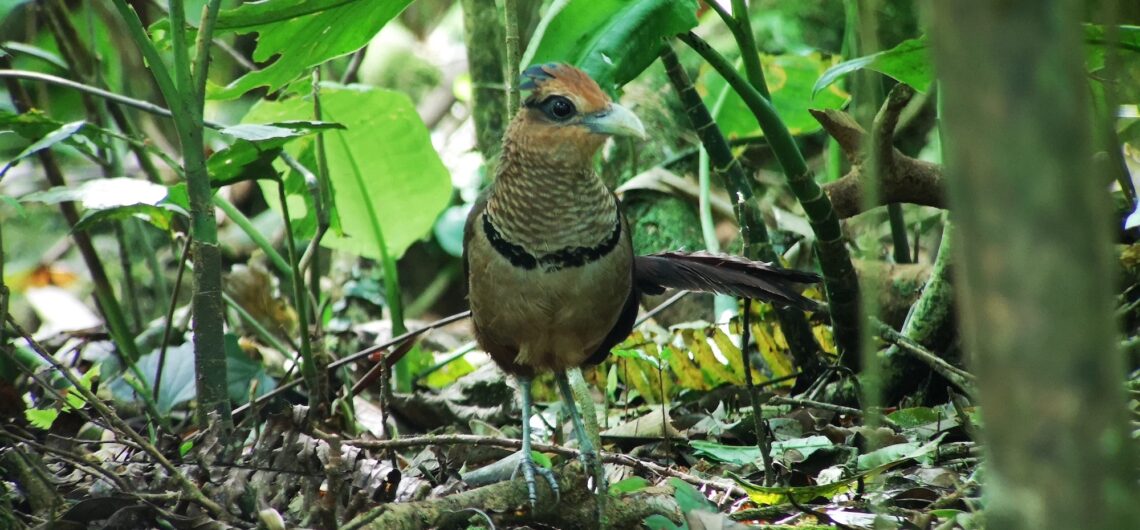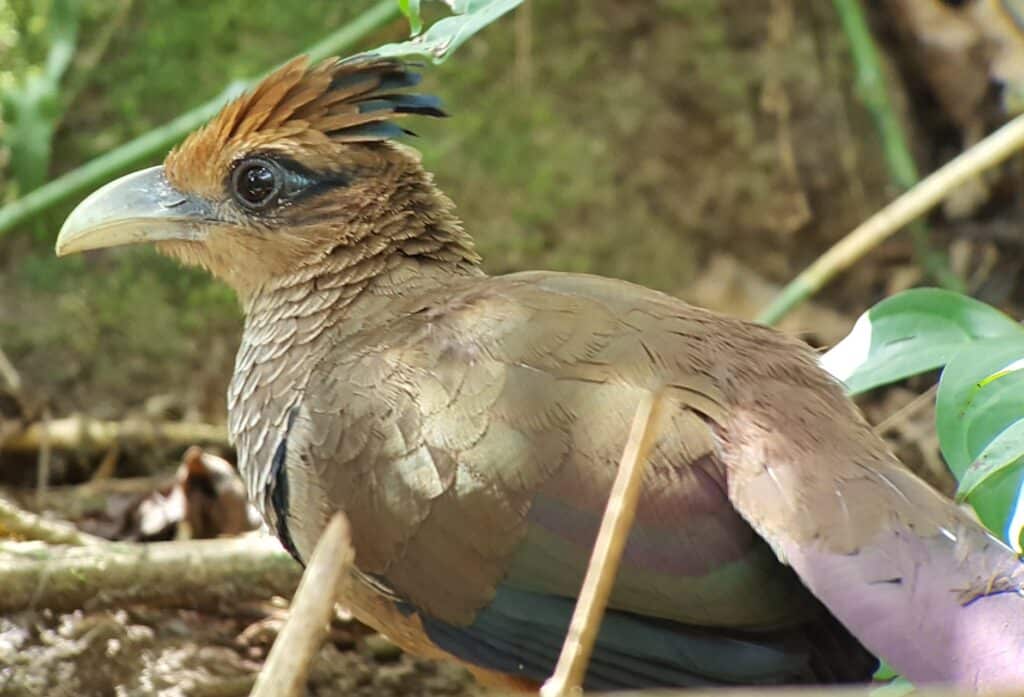Rufous-vented Ground-Cuckoo
Neomorphus geoffroyi
Photo by Danilo Rodríguez Jr.
The Rufous-vented Ground-Cuckoo is a beautiful but infrequently encountered bird. Like the other four species of ground-cuckoo in its genus, it is renowned for its scarcity and its highly elusive habits. In appearance, the Rufous-vented Ground-Cuckoo might be described as an oversized colorful roadrunner—not incidentally, the Geococcyx roadrunners are considered a sister genus to the Neomorphus ground-cuckoos—with a prominent crest, a thick yellowish bill, bare blue skin around its eye, a long tail, and a plumage of green, purple, and bronze hues.
Rufous-vented Ground-Cuckoos are almost always observed in the vicinity of large swarms of army ants, foraging on or near the ground by picking off the insects, arachnids, and small vertebrates such as lizards and frogs that the ants disturb as they swarm across the forest floor. Finding these antswarms can be very productive from a birder’s perspective, as many different birds can be observed foraging in this manner including other difficult species such as the Ocellated Antbird (Phaenostictus mcleannani), but the Neomorphus ground-cuckoos are undoubtedly the rarest and most sought-after of all the antswarm followers. The presence of a ground-cuckoo may be indicated by its deep moaning or cooing vocalization or by the loud clacking of its bill that it uses as an alarm or to communicate with other ground-cuckoos. Even once a ground-cuckoo is located at an antswarm, its shy nature and the often dense undergrowth of its habitat can make it difficult to see. Less frequently, Rufous-vented Ground-Cuckoos may also forage in association with groups of peccaries or monkeys.
The Rufous-vented Ground-Cuckoo occurs locally in areas of undisturbed primary forest. The northernmost population (subspecies salvini) occurs in parts of Nicaragua and Honduras, along the Caribbean slope of Costa Rica, through Panama, and into northern Colombia. Five additional subspecies, differing in some details of plumage coloration and pattern, occur in South America as far south as Brazil and Bolivia. The other four Neomorphus species (the Scaled, Banded, Rufous-winged, and Red-billed Ground-Cuckoos) occur only in South America. Although the Rufous-vented Ground-Cuckoo is the most widespread member of its genus, its isolated populations, low density, and dependence on primary forest render it vulnerable to habitat disturbance.
Within Panama, the Rufous-vented Ground-Cuckoo occurs on the Caribbean slope in the western half of the country, and on both the Caribbean and Pacific slopes in the eastern half. This “holy grail” of Neotropical birding has been recorded from the world-famous Pipeline Road near the Canopy Tower, but chances of seeing it are better near the Canopy Lodge. Dr. Kevin Zimmer (renowned international birding tour leader and researcher) wrote for the magazine Neotropical Birding in 2011 that “in recent years, perhaps the most reliable place for seeing Rufous-vented Ground-Cuckoo has been the foothill forest above El Valle de Antón, Coclé Province, Panama, particularly near the grounds of the Canopy Lodge and the contiguous Canopy Adventure,” after he was able to watch one at an antswarm for about 45 minutes with our Canopy Family guides!
Photo by Danilo Rodríguez Jr.
References:
Angehr, G. R., and R. Dean (2010). The Birds of Panama: A Field Guide. Zona Tropical, San José, Costa Rica.
Healy, T. P., R. B. Payne, C. J. Sharpe, and G. M. Kirwan (2020). Rufous-vented Ground-Cuckoo (Neomorphus geoffroyi), version 2.0. In Birds of the World (S. M. Billerman, B. K. Keeney, and T. S. Schulenberg, Editors). Cornell Lab of Ornithology, Ithaca, NY, USA. https://doi.org/10.2173/bow.rvgcuc1.02.
Zimmer, K. J. (2011). “Photospot: Rufous-vented Ground Cuckoo Neomorphus geoffroyi.” Neotropical Birding 8: 68-73.


